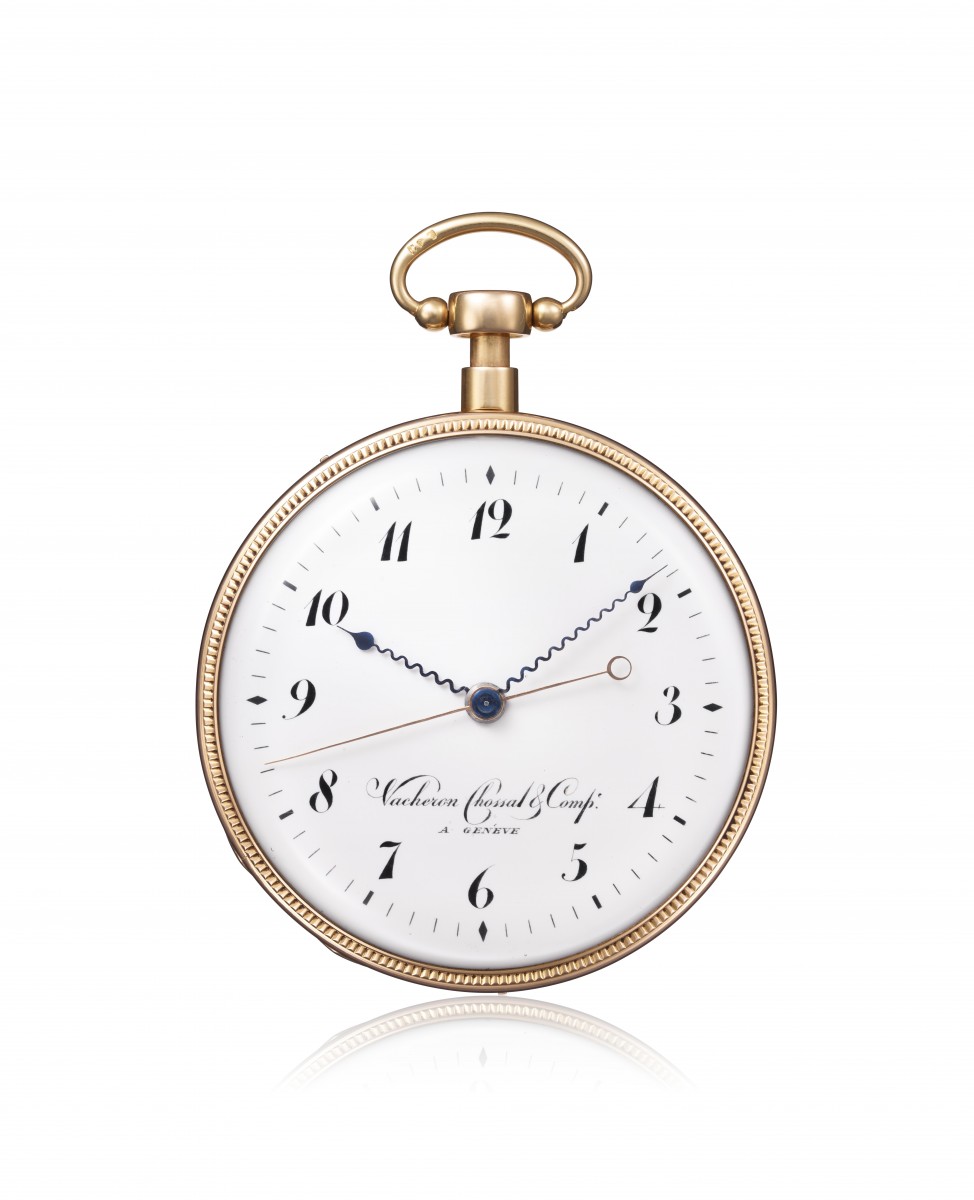Source: Images and content by Vacheron Constantin
http://content.presspage.com/uploads/1999/500_vac-hwm-striking-ref-inv-12085.jpg?10000
• Invented at the end of the 17th century, striking watches put their mechanical complexity at the service of real musical instruments.
• Jean-Marc Vacheron created an alarm watch for his final project required to graduate as a watchmaker in the late 1740s, even before founding the Maison bearing his name
• The first known mention of a Vacheron Constantin striking model in production records dates back to 1806, with a gold quarter-repeater pocket watch.
• For two and a half centuries, the Maison has been renowned for its watches with audible indications and ultra-thin mechanisms
Geneva, 27 September 2021 – Invented at the end of the 17th century to tell the time at night, striking watches, represent a horological complication that is both intimate because of the intense emotion they arouse, and poetic because they distil a melodic expression of time. Another particularity is that, in the absence of additional functions, they are barely distinguishable aesthetically from classic two- or three-hand watches, despite their great mechanical complexity. Since its beginnings, Vacheron Constantin has demonstrated acknowledged expertise in the realm of striking watches.
The origins of striking watches
In the watchmaking universe, striking watches are often regarded as masterpieces that combine mechanical science with the auditory qualities of musical instruments to transform the passing of time into sounds, even tunes. Back in the days when electricity was still a completely unknown word, striking watches emerged for a practical reason: to tell the time in the dark. Among the oldest repeater strikeworks, the first appeared in the quarter-repeater watch that was first developed towards the end of the 17th century. This was made possible by the 1675 invention of the balance-spring, which ensured greater precision, as well as the introduction of the minutes hand. Watches no longer indicated only the hours, but also the minutes, or at least the quarters. Watchmakers were therefore able to concentrate on their use in the dark, a challenge taken up by Vacheron Constantin, which distinguished itself in 1819 already with a quarter-repeater watch also featuring independent deadbeat seconds.
Although the first minute repeater watches were made in Germany around 1710, they were perfected towards the end of the century by replacing bells without clappers by gong springs. The use of these circular blades, which can be found in contemporary striking watches, served to considerably reduce the thickness of the cases and obtain a clearer sound. This skill was perfectly mastered at Vacheron Constantin, whose records mention the first repeater watch in 1806. Grande Sonnerie watches, considered the ultimate examples of timepieces with audible indications, took another two decades to emerge. In 1827, the company introduced the first timepiece with Grande and Petite Sonnerie. The watchmaking reached a new pinnacle with these models, which were highly appreciated among aristocrats and bourgeois alike but remained very rare because they were extremely difficult to make. The invention of the match in 1845 (and its contribution to night-time visibility) made the production of these striking timepieces even rarer, reinforcing their aura as truly legendary watches.
The minute repeater, a nocturnal complication
A repeater watch features a mechanism that indicates the time on demand. This is in contrast to the concept of “striking on the hour”, which is automatically triggered on passing the hours or quarters as on a clock. In a traditional minute repeater, two hammers strike two gongs with different tones, indicating the hours with low notes, the quarters with a double high and low note, and finally the minutes with high notes. Such a mechanism consists of a dedicated sliding bolt piece, a barrel and a regulating system, which is generally independent of the watch mechanism. Activating the sliding bolt causes a rack to arm the barrel spring of the alarm, which is then ready for use. Once released, the energy is transmitted via a wheel system, which is regulated by a flywheel in order to maintain a constant striking rhythm.
The strikework consists of a mechanical memory system, along with hammers and gongs. As it winds the strikework barrel, the sliding bolt simultaneously releases three feeler-spindles which pick up time information from the hour, quarter and minute cams. These spiral-shaped rotating ‘snail’ cams serve to adjust the number of strokes that the hammers must strike. The first cam for the hours has 12 steps, the second has four steps for the quarters and the last one, which is star-shaped, features 14 steps on each of the four branches for the minutes between each quarter. At the same time as they pick up the information from the snail, the feeler-spindles position the racks or rakes at the other end of their arm at such a distance that, once released, they activate the hammers in a manner corresponding to the right number of strokes, at the rate of one fingerpiece per stroke.
Grande Sonnerie mechanisms a question of energy
The Grande Sonnerie is one of the most difficult horological complications to achieve. Its distinctive feature lies in its ability to strike the hours and quarters with a reminder of the hour at each quarter. Most of these timepieces also have a Petite Sonnerie function, without a reminder of the hour at each quarter, and a silence function serving to pause the mechanical ballet of the hammers. The Westminster chime, the most complex of the Grande Sonnerie mechanisms, refers to the melody of the bells of Big Ben – the clock tower on the northern end of the British Houses of Parliament building in London – which consists of four bars of four notes each, played at different frequencies. The device thus requires a greater number of gongs and hammers of four or even five in the most melodious models.
The mechanical principle of Grande Sonnerie is basically the same as that of a minute repeater. The latter generally complements the Grande and Petite Sonnerie mechanisms. The main difference lies in energy management. Unlike repeater mechanisms, which have a sliding bolt that serves to wind the spring on demand, Grande Sonnerie models must use the force of the movement to indicate the time 96 times a day. This constraint is all the more delicate in that it involves activating hammers to strike gongs with sufficient impact to make this operation – repeated 366 times a day – as clearly audible as possible. For this reason, these timepieces are generally equipped with two barrels, one for the movement and the second for the strikework.
The sound quality of a striking watch depends on a multitude of factors, starting with the shape and orientation of the hammers, the material, length and shape of the gongs, as well as their attachment point in the watch. Other decisive elements to be take into consideration are the material and structure of the case, which may house a resonance chamber or even feature openings on the back, or a metal grid designed to enhance sound propagation. Finally, it is the mastery of the watchmaker and his empirical knowledge that makes the difference. Responsible for adjusting the constituent parts of the movement, tuning the musical device, individually adorning each component one by one and assembling the calibre several times for a perfect result, his or her expertise is irreplaceable.
Given that this sound quality helps define the personality of a watch, in 2019 Vacheron Constantin entrusted Abbey Road Studios with making a unique sound recording for each of the models composing its “La Musique du Temps®” range. For the first time, these repeater watches have thus received a unique sound print, recorded and certified by Abbey Road Studios.
Vacheron Constantin and striking watches: an early reputation
Striking watches have been part of Vacheron Constantin’s heritage right from the outset. At the end of his apprenticeship, which began in 1744, Jean-Marc Vacheron was required to make a portable alarm watch as part of his final project, a prerequisite for being admitted to the watchmaking profession at that time. Is this why the Maison was to show a particular inclination for timepieces with audible indications, including repeater timepieces and Grande Sonnerie models alongside alarm watches? Whatever any case, throughout its 266 years, Vacheron Constantin has developed a passion and consequently acknowledged expertise in the creation of these complications, which are considered the crowning achievement of the watchmaking art. In keeping with its concern for elegance, the Maison has placed its watchmaking expertise at the service of ultra-thin movements, an additional technical difficulty in the creation of such timepieces, and of remarkable watches with extremely sophisticated complications.
The workshops of the Maison thus participated in the creation of the first generations of repeater watches and the company records show an initial reference dating from 1806. The annals of Charles Constantin (1887-1954) mention that in 1811, the Maison delivered in France “beautiful musical repeater watches” featuring “the finest craftsmanship, playing in two tunes on demand and at will”. From that time on, Vacheron Constantin’s reputation for making such models was well established. As the correspondence in its archives reveals, the Maison was regularly called upon in the second half of the 19th and early 20th centuries to meet orders for striking watches on behalf of prestigious clients such as the Queen of Romania and the Infanta Isabel. These creations also included Grande Sonnerie models, such as the 1827 timepiece in the Vacheron Constantin private collection.
Grand Complication striking models
The advent of the wristwatch did nothing to dampen customers’ desire for pocket models capable of telling the time. However, demand became more complex as Vacheron Constantin developed particular expertise in highly complicated timepieces. Several exceptional watches mark the Maison’s history, which experienced a veritable golden age at the turn of the century. These include the watch commissioned by the Swiss colony in Egypt and presented to King Fouad in 1929, as well as the one acquired in 1946 by his son, King Farouk, through his brother-in-law after a visit to Switzerland. This yellow gold masterpiece required no less than five years of development because of its 14 complications, including a minute repeater with a carillon and a Grande and Petite Sonnerie mechanism equipped with three gongs, as well as an alarm clock, a split-seconds chronograph, a perpetual calendar and an indication of the phases and age of the moon. Two years later, Vacheron Constantin fulfilled another prestigious order for Count Guy du Boisrouvray, a large yellow gold watch with hunter-type case equipped with a three-gong minute repeater featuring an alarm, perpetual calendar and split-seconds chronograph. Until 2015, this remained the third most complicated watch ever made by Vacheron Constantin.
In 2005, on the occasion of its quarter-millennium anniversary, the company presented the Tour de l’Île wristwatch, a world first comprising 16 complications, driven by 834 components, which were read on a double-sided display. In 2015, for its 260th anniversary, Vacheron Constantin presented Reference 57260, then the most complicated watch in the world with its 57 functions. Among the many time, calendar and astronomical functions of these two timepieces, the striking of the alarm takes pride of place in the form of minute repeaters, complemented in Reference 57260 by a Grande and Petite Sonnerie mechanism with a Westminster chime striking five gongs and an alarm function.
The Manufacture’s centuries-old penchant for ultra-complicated timepieces is notably perpetuated in particular within the Les Cabinotiers department, which is in charge of single-piece editions and custom-made watches made at Vacheron Constantin. Over the years, Les Cabinotiers has designed creations incorporating striking functions, such as the Astronomica wristwatch in 2014 with its 15 complications combining a minute repeater and a tourbillon with astronomical-type indications. In 2020, the master watchmakers of the Les Cabinotiers department developed several single-piece editions striking watches on the theme “The Music of Time”. Among them was the Symphonia Grande Sonnerie – The Sixth Symphony watch, whose case middle features a bas-relief engraving of a musical score from Beethoven’s Sixth Symphony. This model echoes the Symphonia Grande Sonnerie 1860 watch launched in 2017, the first Grande Sonnerie wristwatch in the history of Vacheron Constantin. For the latter model, the feat consisted in bringing together the 727 components of the Grande Sonnerie and minute repeater movement within a calibre measuring 37 mm in diameter and 9.1 mm thick.
Slimness records
Reference 4261 represents an important milestone in the development of the Maison’s striking watches. With this creation dating from the early 1940s, Vacheron Constantin did more than meet the technical challenge of a minute repeater, since it also sought to create an ultra-thin calibre measuring just 3.28 mm thick. With its case measuring 5.25 mm thick and 36 mm in diameter, along with its drop-shaped lugs, this creation is one of the brand’s legendary watches, produced as fewer than 40 pieces.
In the 1990s, the company was naturally inspired by Reference 4261 to design a new model equipped with Calibre 1755, featuring an equally thin minute repeater, i.e. 3.28 mm thick (Reference 30010), also available with a perpetual calendar module (Reference 30020) or in a skeletonised version (Reference 30030). Only 200 timepieces representing these three references were produced, notably culminating in a world record for the 1755 movement as the thinnest in its category at the time.
In 2007, before distinguishing itself again in the realm of ultra-thin striking watches, Vacheron Constantin presented the Patrimony Traditionnelle Calibre 2755, inspired by the research carried out for the Tour de l’Île watch in 2005. This tourbillon timepiece, which also incorporates a perpetual calendar, is Vacheron Constantin’s first minute repeater to feature a perfectly silent centripetal strike regulator that balances the rate at which the hammers strike. This ingenious system comprises two weights designed to act as a brake on the regulator’s axis of rotation, thus evening out the energy from the barrel spring.
This invention is reflected in the movement of the Patrimony Contemporaine Calibre 1731, which set a new record for thinness in 2013, housed in a case measuring 41 mm and 8.09 mm thick. Endowed with a 65-hour power reserve, this minute repeater movement stemming from four years of development was marginally thicker than its predecessor, at 3.90 mm compared to the 3.28 mm of the Calibre 1755 unveiled in 1992.
Jewellery and striking watches
Almost all contemporary striking watches feature generous proportions in terms of diameter so that the case can best fulfil its role as a sounding board. This requirement means that these models are generally not very well suited to women’s wrists and are therefore of greater interest to male collectors.
This was however not always the case in the world of pocket watches and hence of the first repeater watches. Back in the day, women’s timepieces, often regarded as jewellery watches, were worn on long chatelaine necklaces or as pendants and not hidden from view in men’s waistcoat pockets. These mechanical watches capable of telling the time were doubly attractive to devotees of fine watchmaking, enabling them to tell the time at night and by day to wear a magnificent ornament reflecting the scientific knowledge of the time and the decorative arts.
Vacheron Constantin thus produced a number of pocket watches with striking mechanisms intended for representatives of the nobility as well as a certain financial aristocracy. With their engraved gold cases, enamel or silver dials, repeater and even Grande Sonnerie movements, these richly decorated pieces were among the “treasures” of high-society women, as reflected in the historical correspondence of the Maison. Their practicality was not the least of their assets, well after the turn of the 20th century. In a letter written in 1937, the Marquise de Riencourt asked Vacheron Constantin: “Having completely lost my sight, I once again need a repeater watch, especially for night time. (…) In gold or silver, striking quarter hours and half hours”.
Watch selection
Pink gold musical quarter repeater pocket watch (Ref. Inv. 10468) – 1816
The history of musical mechanisms built into timepieces gives the dates of 1796 for the invention of the comb-made steel elastic prongs and 1811 for the first mention of a musical repeater. This 1816 pocket watch, equipped with a musical quarter-repeater mechanism, represents one of the very first models of this type of timepiece. It is particularly well executed with a pink gold case and dial, engraved and guilloché dial bearing enamelled cartouches for the hours. The musical repeater is based on a rotating toothed disk that is integral to the barrel of the metal blade mechanism.
Pink gold quarter-repeating pocket watch with deadbeat seconds (Ref. Inv. 12085) – 1819
This pink gold quarter-repeater pocket watch featuring an enamelled dial and serpentine hands is equipped with a deadbeat seconds hand, a rare complication for the time that prefigures the invention of the chronograph.
Yellow gold reference 3620 “Don Pancho” wristwatch – 1935
Reference 3620 is one of only three wristwatches known to have been produced before 1940 that combine a minute repeater and calendar indication – in this instance by means of a retrograde hand. It took several years to make this watch, which was delivered in 1940 and whose functions were at the time usually reserved for pocket watches. Known as the Don Pancho, this yellow gold model is distinguished by its tonneau shape, its crown at 12 o’clock and its minute repeater with deliberately low tones, activated by a right-hand slide. The calendar functions offer a day of the week indication in the small seconds counter, complemented by a date with a central retrograde hand.
Pink gold Reference 4261 minute repeater wristwatch (Ref. Inv. 11420) – 1941
Given the complexity of minute repeater wristwatches in the mid-20th century, only a very small number were produced. With the creation of Reference 4261 in the early 1940s, Vacheron Constantin took up the twofold technical challenge of producing a thin minute repeater movement. Ultra-thin Calibre 4261 is only 3.28 mm thick. With its 36 mm-diameter case, its drop-shaped lugs and its crown integrated into the case middle, this creation is one of the most elegant minute repeater wristwatches ever created. The model remained in production until 1951, and only 36 examples were made.
Yellow gold King Farouk Grand Complication pocket watch – 1946
Vacheron Constantin created one of the most complicated watches of its time for King Farouk of Egypt. This imposing model, measuring 80 millimetres in diameter and which took more than five years to complete, is fitted with 13 hands. Its calibre incorporates 820 components driving 14 complications. Made between 1930 and 1935, this double gear-train watch in 18K yellow gold remained in King Farouk’s collection until 1954. It includes a minute repeater with carillon and a Grande and Petite Sonnerie mechanism equipped with three gongs and three hammers, a split-seconds chronograph with a 30-minute counter, a perpetual calendar, an indication of the phases and age of the moon, an alarm clock and two power-reserve indicators.
Platinum Reference 30020 wristwatch (Ref. Inv. 11586) – 1993
With the revival of the mechanical watch in the late 1980s, Vacheron Constantin reintroduced a legendary complication, the minute repeater, based on the ultra-thin movements that forged its reputation in the 1940s. Calibre 1755 was presented in three versions: the 3.28 mm thick minute repeater Reference 30010, the openworked Reference 30030 and the minute repeater Reference 30020 with perpetual calendar module. Shown here in a 36 mm platinum case with drop-type lugs, the model is equipped with Calibre 1755 QP, which is just 4.9 mm thick.
Pink gold Tour de l’Île wristwatch (Ref. Inv. 11474) – 2005
Vacheron Constantin’s 250th anniversary celebration in 2005 was a strategic event in terms of product development, driven by a determination to create an exceptional watch. The project gave rise to the Tour de l’Île watch, housing the 834 components of Calibre 2750. Only seven of these timepieces were offered for sale between 2005 and 2007, including the first with a black dial offered at an auction dedicated to the company’s 250th anniversary. At the time of its launch, the Tour de l’Île was the world’s most complicated wristwatch, with a double-sided case displaying 12 hands for 16 complications, including a minute repeater with a striking-level indication.
White gold Reference 57260 – 2015
Unveiled on September 17th 2015 on the occasion of the Maison’s 260th anniversary, the Reference 57260 is the most complicated watch ever made. The result of eight years of work, it features 57 complications in total. Commissioned by a passionate collector, Reference 57260 illustrates the expertise of the Les Cabinotiers workshop, which perpetuates the tradition of excellence and made-to-measure craftsmanship. In terms of audible indications, it is equipped with a five-gong Grande and Petite Sonnerie mechanism to sound the tune played by Big Ben. To activate the strikework at any time, the mechanism is also equipped with a minute repeater, complemented by an alarm function. Each of these functions has its own power reserve with a torque indicator for the alarm which can be activated in normal or carillon mode.
Yellow gold Les Cabinotiers Sonnerie Westminster – Tribute to Johannes Vermeer – 2021
A project first undertaken in 2013, this custom-made yellow gold pocket watch is a demonstration of the expertise in mechanical High Watchmaking and the decorative arts. It is equipped with the new Manufacture Calibre 3761 movement, developed by the team of watchmakers of the Reference 57260 watch. This 806-component hand-wound calibre, regulated by a tourbillon, features Grande and Petite Sonnerie Westminster mechanisms, coupled with a minute repeater. The officer-type cover on the back of the 98 mm case is graced with a miniature enamel-painted reproduction of Vermeer’s Girl with a Pearl Earring. Hand-engraved friezes adorn the sides of the case, while the bezel is embellished with two roaring lion heads sculpted from a block of gold.







